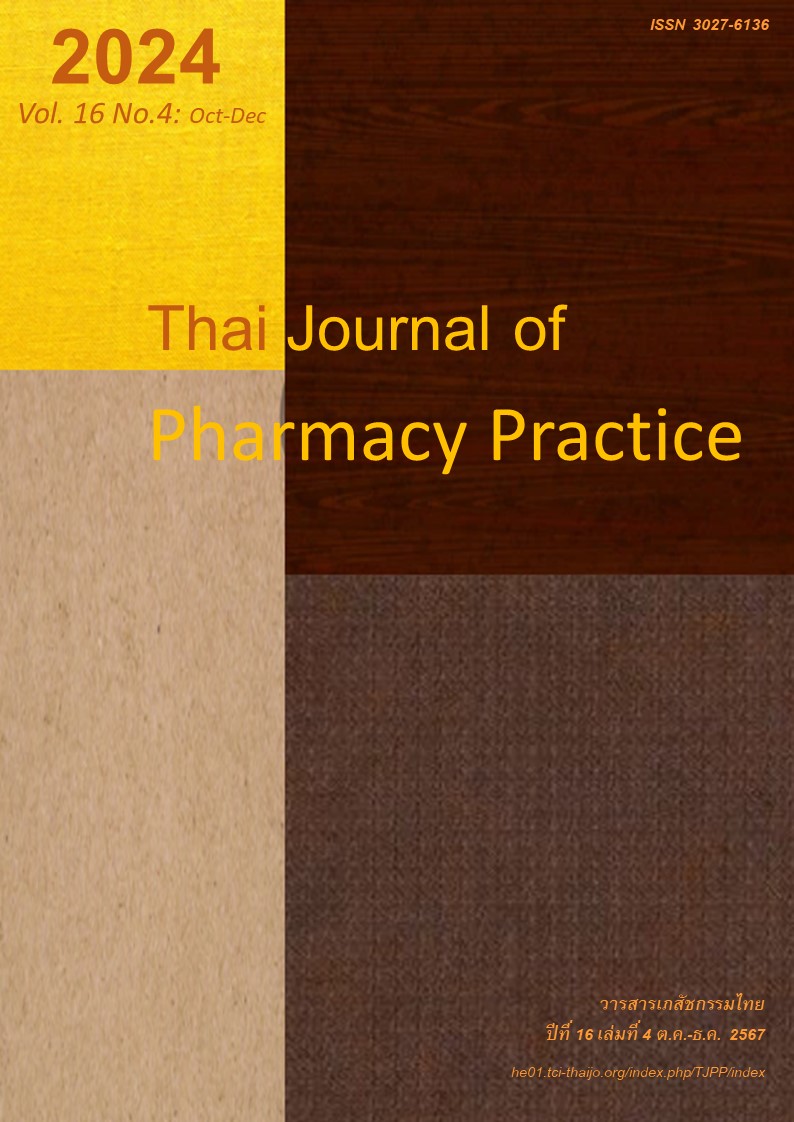รูปแบบการใช้ยารักษาโรคปวดศีรษะไมเกรนในชุมชนออนไลน์
Main Article Content
บทคัดย่อ
วัตถุประสงค์: เพื่อสำรวจรูปแบบการใช้ยาของผู้ป่วยโรคปวดศีรษะไมเกรนในชุมชนออนไลน์ วิธีการ: การศึกษาเชิงพรรณนาแบบภาคตัดขวาง (cross-sectional descriptive study) ครั้งนี้เก็บข้อมูลโดยใช้แบบสอบถามที่เผยแพร่ทางระบบสื่อสังคมออนไลน์ในช่วง 3 เดือน ตัวอย่าง คือ ผู้ที่ปวดศีรษะไมเกรนที่ผ่านการคัดกรองด้วย ID-Migraine™ questionnaire การศึกษาเก็บข้อมูลการรักษาด้วยยาของตัวอย่างและเปรียบเทียบปัจจัยต่าง ๆ ระหว่างกลุ่มผู้ที่ได้รับผลกระทบจากไมเกรนในระดับไม่มี/น้อยมาก-น้อย (MIDAS grade I-II) และระดับปานกลาง-มาก (MIDAS grade III-IV) ผลการวิจัย: ผู้เข้าร่วมการศึกษาทั้งหมด 281 คน ส่วนใหญ่เป็นเพศหญิง (ร้อยละ 90.0) อยู่ในช่วงอายุ 18-29 ปี (ร้อยละ 55.9) มีโรคประจำตัวเป็นอาการนอนไม่หลับสูงสุด (ร้อยละ 21.7) ส่วนใหญ่มีอาการปวดศีรษะไมเกรนชนิดไม่มีอาการนำ (migraines without aura) ร้อยละ 72.2 และเป็นอาการปวดศีรษะไมเกรนเรื้อรัง ร้อยละ 16.4 ตัวอย่างมีอาการปวดศีรษะระดับปานกลาง-มากในช่วงสามเดือนที่ผ่านมา โดยมีค่ามัธยฐานความปวด (ควอไทล์ล่าง, ควอไทล์บน) เท่ากับ 7.0 (6.0, 8.0) คะแนน (พิสัยที่เป็นไปได้ คือ 0-10) ปัจจัยกระตุ้นให้เกิดการกำเริบของอาการที่พบมากที่สุด คือ ความเครียด สำหรับรูปแบบการรักษาของตัวอย่างส่วนใหญ่ คือ การดูแลรักษาด้วยตนเองหรือไม่เข้ารับการรักษา (ร้อยละ 59.4) ยาบรรเทาอาการที่ใช้สูงสุด คือ ยา paracetamol (ร้อยละ 54.8 ของผู้ใช้ยาบรรเทา) ส่วนใหญ่ไม่ใช้ยาป้องกันอาการ (ร้อยละ 65.1) ยาป้องกันอาการที่ใช้สูงสุด คือ ยากลุ่ม tricyclic antidepressants (ร้อยละ 25.5 ของผู้ใช้ยาป้องกัน) โดยมีพฤติกรรมการใช้ยาป้องกันอาการเฉพาะเวลามีอาการปวดศีรษะ ทั้งนี้ พบผู้ที่ได้รับผลกระทบระดับปานกลาง-มาก มีความปวดและรายการยามากกว่าผู้ที่ได้รับผลกระทบระดับไม่มี/น้อยมาก-น้อย สรุป: ผู้ป่วยโรคศีรษะไมเกรนส่วนใหญ่ในสังคมออนไลน์มีรูปแบบการรักษาด้วยตนเอง และยังพบรูปแบบการใช้ยาบรรเทาและยาป้องกันอาการปวดศีรษะไมเกรนที่ไม่เหมาะสม บุคลากรทางการแพทย์ควรให้ความรู้ความเข้าใจแก่ผู้ป่วยเพื่อให้การใช้ยามีประสิทธิภาพและปลอดภัย
Article Details

อนุญาตภายใต้เงื่อนไข Creative Commons Attribution-NonCommercial-NoDerivatives 4.0 International License.
ผลการวิจัยและความคิดเห็นที่ปรากฏในบทความถือเป็นความคิดเห็นและอยู่ในความรับผิดชอบของผู้นิพนธ์ มิใช่ความเห็นหรือความรับผิดชอบของกองบรรณาธิการ หรือคณะเภสัชศาสตร์ มหาวิทยาลัยสงขลานครินทร์ ทั้งนี้ไม่รวมความผิดพลาดอันเกิดจากการพิมพ์ บทความที่ได้รับการเผยแพร่โดยวารสารเภสัชกรรมไทยถือเป็นสิทธิ์ของวารสารฯ
เอกสารอ้างอิง
Stovner LJ, Nichols E, Steiner TJ, Abd-Allah F, Abdelalim A, Al-Raddadi RM, et al. Global, regional, and national burden of migraine and tension-type headache, 1990-2016: a systematic analysis for the Global Burden of Disease Study 2016. Lancet Neurol 2018; 17: 954-76.
Ge R, Chang J. Disease burden of migraine and tension-type headache in non-high-income East and Southeast Asia from 1990 to 2019. J Headache Pain 2023; 24: 32.
Lipton RB, Silberstein SD. Episodic and chronic migraine headache: breaking down barriers to optimal treatment and prevention. Headache 2015; 55 Suppl 2: 103-26.
Manack AN, Buse DC, Lipton RB. Chronic migraine: epidemiology and disease burden. Curr Pain Headache Rep 2011; 15: 70-8.
Xu J, Kong F, Buse DC. Predictors of episodic migraine transformation to chronic migraine: A systematic review and meta-analysis of observational cohort studies. Cephalalgia 2019; 40: 503-16.
Kulkantrakorn K. Chronic migraine. Thai Journal of Neurology 2016; 32: 34-7.
Blumenfeld AM, Bloudek LM, Becker WJ, Buse DC, Varon SF, Maglinte GA, et al. Patterns of use and reasons for discontinuation of prophylactic medications for episodic migraine and chronic migraine: results from the second international burden of migraine study (IBMS-II). Headache 2013; 53: 644-55.
Martelletti P, Schwedt TJ, Lanteri-Minet M, Quintana R, Carboni V, Diener HC, et al. My Migraine Voice survey: a global study of disease burden among individuals with migraine for whom preventive treatments have failed. J Headache Pain 2018; 19: 115.
Lipton RB, Dodick D, Sadovsky R, Kolodner K, Endicott J, Hettiarachchi J, et al. A self-administered screener for migraine in primary care: The ID Migraine validation study. Neurology 2003; 61: 375-82.
Lipton RB, Bigal ME, Diamond M, Freitag F, Reed ML, Stewart WF. Migraine prevalence, disease burden, and the need for preventive therapy. Neurology 2007; 68: 343-9.
Vongvaivanich K, Yongprawat T, Jindawong N, Chansakul C. Test-retest reliability of the Thai migraine disability assessment (Thai-MIDAS) questionnaire in Thai migraine patients. Bangkok Medical Journal 2018; 14: 10-5.
Thai Headache Society. Thai clinical practice guide- line of migraine. Bangkok: Tana press; 2022.
Dixon SJ. Distribution of Facebook users worldwide as of January 2023, by age and gender 2023 [cited Aug 29, 2023]. Available from: www.statista.com/ statistics/376128/facebook-global-user-age-distribu tion/.
Steiner TJ, Stovner LJ. Global epidemiology of migraine and its implications for public health and health policy. Nat Rev Neurol 2023; 19: 109-17.
Eikermann-Haerter K, Dileköz E, Kudo C, Savitz SI, Waeber C, Baum MJ, et al. Genetic and hormonal factors modulate spreading depression and transient hemiparesis in mouse models of familial hemiplegic migraine type 1. J Clin Invest 2009; 119: 99-109.
Labastida-Ramírez A, Rubio-Beltrán E, Villalón CM, MaassenVanDenBrink A. Gender aspects of CGRP in migraine. Cephalalgia 2019; 39: 435-44.
Buse DC, Loder EW, Gorman JA, Stewart WF, Reed ML, Fanning KM, et al. Sex differences in the prevalence, symptoms, and associated features of migraine, probable migraine and other severe headache: results of the American Migraine Preva- lence and Prevention (AMPP) Study. Headache 2013; 53: 1278-99.
Tiseo C, Vacca A, Felbush A, Filimonova T, Gai A, Glazyrina T, et al. Migraine and sleep disorders: a systematic review. J Headache Pain 2020; 21: 126.
Yeh WZ, Blizzard L, Taylor BV. What is the actual prevalence of migraine? Brain Behav 2018; 8: e00950.
Kelman L. Pain characteristics of the acute migraine attack. Headache 2006; 46: 942-53.
Kelman L. The triggers or precipitants of the acute migraine attack. Cephalalgia 2007; 27: 394-402.
Pringsheim T, Davenport WJ, Marmura MJ,Schwedt TJ, Silberstein S. How to apply the AHS evidence assessment of the acute treatment of migraine in adults to your patient with migraine. Headache 2016; 56: 1194-200.
May A, Schulte LH. Chronic migraine: risk factors, mechanisms and treatment. Nat Rev Neurol 2016; 12: 455-64.
Serrano D, Buse DC, Manack Adams A, Reed ML, Lipton RB. Acute treatment optimization in episodic and chronic migraine: results of the American Migraine Prevalence and Prevention (AMPP) Study. Headache 2015; 55: 502-18.
Bernstein C, Burstein R. Sensitization of the trige- minovascular pathway: perspective and implications to migraine pathophysiology. J Clin Neurol 2012; 8: 89-99.
Buse DC, Manack AN, Fanning KM, Serrano D, Reed ML, Turkel CC, et al. Chronic migraine prevalence, disability, and sociodemographic factors : results from the American Migraine Prevalence and Prevention Study. Headache 2012; 52: 1456-70.
Suthisisang C, Poolsup N, Kittikulsuth W, Pudcha kan P, Wiwatpanich P. Efficacy of low-dose ibuprofen in acute migraine treatment: systematic review and meta-analysis. Ann Pharmacother 2007; 41: 1782-91.
Harrell TK, Minor DS. Headache Disorders. In: DiPiro JT, Yee GC, Posey LM, Haines ST, Nolin TD, Ellingrod V, editors. Pharmacotherapy: A pathophy- sio logic approach. 11th ed. New York, NY: McGraw-Hill Education; 2020. p. 989-1005.
Chia V, Bogdanov A, Yusuf A, Kallenbach L. Characteristics of migraine patients with Migraine Disability Assessment (MIDAS) scores in real-world clinical practice. Cephalalgia Rep 2020; 3: 25158163 2092846.
Li XY, Yang CH, Lv JJ, Liu H, Zhang LY, Yin MY, et al. Global, regional, and national epidemiology of migraine and tension-type headache in youths and young adults aged 15-39 years from 1990 to 2019: findings from the global burden of disease study 2019. J Headache Pain 2023; 24: 126.
Kim BK, Chu MK, Lee TG, Kim JM, Chung CS, Lee KS. Prevalence and impact of migraine and tension-type headache in Korea. J Clin Neurol 2012; 8: 204-11.


